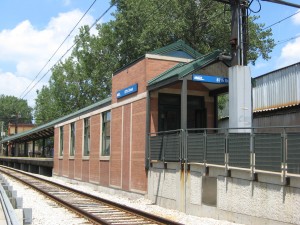Ordinance introduced to accelerate development near public transportation stations
Chronicle Media — August 2, 2015
The proposed ordinance will encourage mixed commercial and residential-use developments near transit stations. Photo by Zol87
Reform Would Add More Than $400 Million to Local Economy Annually
A transit oriented development (TOD) reform ordinance that would create incentives for more development near Chicago Transit Authority (CTA) and Metra stations was introduced to the City Council on July 29.
The new ordinance builds upon the Mayor Rahm Emanuel’s 2013 TOD ordinance by expanding the size of the TOD zones, eliminating the parking requirements in these areas altogether, and adding new incentives for affordable housing.
According to a preliminary analysis by the Metropolitan Planning Council (MPC), these reforms would generate more than $400 million in economic activity and $100 million in tax revenue for the City and its sister agencies each year.
The proposed ordinance will encourage mixed commercial and residential-use developments near transit stations. These developments will expand access to transit, bring new amenities to neighborhoods, and foster economic growth across the city. It will make the following enhancements to the zoning code:
- TOD incentives will be available within an expanded radius from a transit station: up to 1,320 feet (1/4 mile) or 2,640 feet (1/2 mile) on a pedestrian-designated street.
- A 100 percent reduction from residential parking requirements if replaced with alternative transportation options, such as a car sharing station on site, or bike parking.
- A streamlined process for accessing the minimum lot area, floor area ratio (FAR), and building height incentives by allowing developers to secure these benefits through an Administrative Adjustment from the Zoning Administrator, as opposed to a zoning map amendment by City Council under current law.
- For projects that trigger the city’s Affordable Requirements Ordinance (ARO), an additional 0.25 FAR increase (to 3.75) if the development includes half of any required affordable housing units on site, plus an additional 0.25 FAR increase (to 4.0) if the development includes all required affordable housing units on site.
??”I was proud to have sponsored the original ordinance, which paved the way for a new 99- unit apartment building in my ward. I support these new reforms, which will bring more buildings to the area adding affordable housing, and generating new taxes that will support more TOD projects,” said Ald. Joe Moreno (1st Ward).
?“It’s important that we continue to identify ways to entice development in close distance to our train stations, and these reforms will bring in more revenue for the city and provide residents with more places to live, work and enjoy the City of Chicago,” said Ald. Danny Solis (25th Ward), Chairman of the Committee on Zoning, Landmarks and Building Standards.
“I have continually promised to bring more positive changes to my ward and I think this should be d now, at a time when we can capitalize on the building boom taking place throughout Chicago. For this and other reasons, zoning is especially important now, and working with Mayor Emanuel and my colleagues in City Council we can bring more development to my ward and across our city and as importantly, generate needed revenues,” said Ald. James Cappleman (46th Ward).
According to the MPC, the Mayor’s reforms would generate more than $400 million in economic activity and $100 million in tax revenue for the City and its sister agencies each year. The MPC’s analysis also evaluated the economic and housing impact by neighborhood.
“Streamlining approvals and expanding incentives for development near transit is a zero-cost way for the city to deliver what people are clamoring for: more places to live, work and shop within walking distance of train stations,” said MarySue Barrett, president, Metropolitan Planning Council. “By increasing incentives for proposals that include affordable housing, the city is clearly signaling that Chicagoans of all incomes should have opportunities to enjoy the benefits of living and working near transit.”
Prior to 2013, the city’s zoning code did not promote development around transit stations. In 2013, the Emanuel Administration passed an ordinance that provided new zoning incentives including reduced parking requirements and greater height and density bonuses for projects near transit stations. To be eligible for the incentives, projects needed to be either within 600 feet of a transit station or 1,200 feet of a transit station along a pedestrian-designated street. To date, the ordinance has facilitated the development of eight projects worth more than $132 million, creating nearly 1,000 construction jobs and 100 permanent jobs. Promoting TOD will drive additional economic development to neighborhoods.
— Ordinance introduced to accelerate development near public transportation stations —



